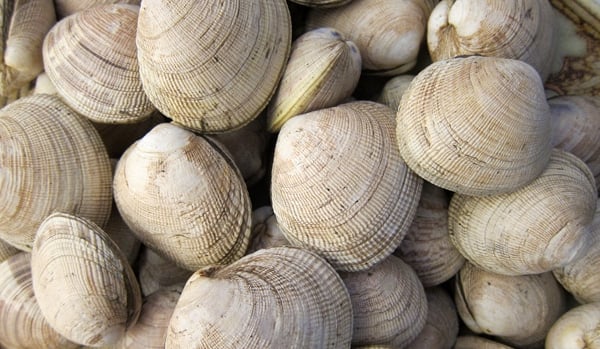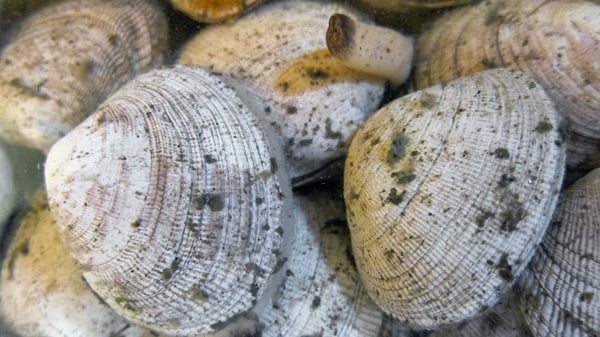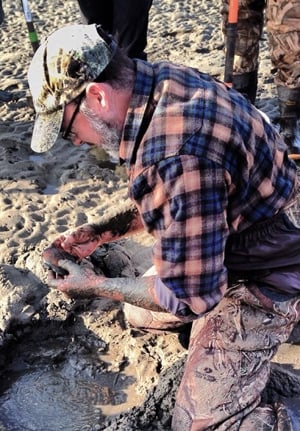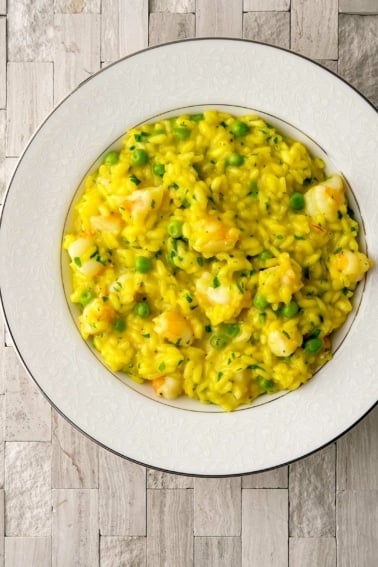As an Amazon Associate I earn from qualifying purchases.

There is a library’s worth of bad information out there about how to purge sand from clams, ranging from mythical to downright scary. Hopefully I can set the record straight. Here’s what you need to know to get the grit out of your clams.
Let me start by saying that the vast majority of clams, mussels and oysters you buy in the market have been purged already. You will almost never need to purge your clams if you bought them at a supermarket. The exception is if you buy from a small purveyor, and in that case just ask: Have you purged your clams?
Wild clams and mussels are an entirely different story.
They should always be purged, clams especially. Different clams need different purging times, too, depending on how and where they live. Hard shell clams in clean sand, like Eastern surf clams, cockles and quahogs, tend to be easier to purge than open-shelled clams like steamers, horseneck clams and geoducks. The worst of them all is the Western bent-nosed clam, which lives in dense mud and can take days to purge.
Adding corn meal to the purging water does nothing. There, I said it. Think about the biology of a clam for a moment to understand why. Clams are filter feeders. The reason they have sand and grit in them is because they live buried in sand or mud. This proximity to grit naturally gets the stuff into the clams, which filter with their shells partially open — which is how the sand or mud gets in. Clams filter microscopic particles, not stones or grains of sand — or corn meal. Clams don’t have gizzards. They don’t need grit to do their jobs. Grit in your shell is just a side effect of being a clam.
The myth is that corn meal somehow causes a clam to “cough up” more grit than it normally would, or that the clam “eats” the corn meal and spits out grit. Well, to test that I did an experiment:
- First, I let 50 Western littleneck clams purge themselves for 18 hours in seawater. They expelled about 47 grams of grit (weighed after drying) after about 18 hours.
- Next, I added exactly 150 grams of coarse corn meal to the purging water and let another 50 Western littleneck clams purge themselves for 18 hours. After that, I carefully removed the clams, poured off the water and spread the corn meal out on a baking sheet to dry completely. Then I weighed it again. The corn meal plus grit weighed 196 grams. You would think that if clams had “eaten” the cornmeal, there would be a decrease in the dry weight of the meal after 18 hours, no?
If you were to bury clams in cornmeal, yes, some would get inside them the way sand does in the wild. But why bother?
Purging clams is mostly a function of time, with oxygen and temperature as ancillary factors.
The single most important ingredient you need to purge your clams of grit is seawater. This is not so hard to obtain if you are getting your own clams. Bring a 5-gallon bucket and fill it 2/3 of the way up with seawater as you leave the clamming grounds. Armed with this, you can purge virtually any clam. Oh, by the way, you cannot purge a clam in fresh water. Fresh water kills clams. And dead clams are, with few exceptions, no good to eat.
Why is bringing home seawater so important? Because clams live at different salinity levels. The average salinity of the ocean is 35 parts of salt per 1000, but in some wide, shallow clam beds the salinity climbs far higher through evaporation. In other beds, the salinity is lower because the clams are near an estuary where fresh water flows. If you bring seawater from where you dug the clams, you need not guess at how salty your soaking water should be.
If for some reason you forgot to bring back seawater, you can recreate it decently by remembering that 35 parts per thousand ratio. Go buy sea salt — actual sea salt, not rock salt, not iodized salt — and dissolve 35 grams of it (about 2 tablespoons plus another teaspoon) into each 1000 grams of non-chlorinated water, which is about 1 liter. You’ll need enough to submerge your clams.
If you want to get fancier, you can use a hydrometer, which measures water density. Where I do a lot of my clamming in Tomales Bay, the average salinity would read 1.024 in terms of specific gravity. This equated to 1/3 cup finely cut sea salt to a half-gallon of non-chlorinated water. Chlorine, needless to say, is not good for living things. What’s your area’s normal salinity? Google it. I bet some scientist somewhere has measured the salinity where you dig clams and put it online.
Temperature matters. Shock kills clams. Put clams living in 75°F water into the fridge and they will not be happy — and open-shelled clams will die. The reverse is also true.
Carry your clams home in your seawater and they’ll be fine. They will acclimate to the changing temperature as you drive home. If it’s really hot or cold out, put everything in a cooler. Keep in mind that clams are capable of filter feeding at temperatures as low as 34.5°F and as high as at least 78°F, which is realistically as warm as you will get in a normal indoor room.
If you’re clamming in winter, where the water is cold, go ahead and do your purge sand from clams in the fridge. But if it’s summer, keep your clams at room temperature, or, ideally, a place a bit colder, like a basement.
How long? Even an hour will help. But you can purge your clams as long as there is oxygen in your seawater. Leave your clams too long, and they suffocate and die. Overnight is what I normally do with a 50-clam limit of Western littlenecks and 4 to 10 horseneck or Washington clams. I submerge the clams by about 1 1/2 to 3 inches of seawater and cover the container they’re in — clams spit water, so you don’t want them sprinkling the inside of your fridge or basement.

So, to sum up, this is how I purge sand from clams:
- When you are done digging, fill a large bucket full of seawater to take home. Put your clams in it for the drive. If the temperature is very different between the water and your car, put everything in a cooler.
- At home, quickly wash every clam under cold tap water to remove mud or grit on the outside of the shell. Put the clams into a large non-reactive container (galvanized steel will kill them, for example). I use a big Tupperware-style container.
- Either let the seawater you brought home settle for 20 minutes or so, or filter it through a paper towel. You want it as grit-free as possible. Pour the water over the clams, covering by 1 to 3 inches. If you are purging especially muddy clams, hold back any remaining seawater — you’ll need to change it in a day.
- Set the clams in the fridge, at room temperature or in a cool place — somewhere where the temperature is reasonably close to the water they were in — and leave for at least an hour, and up to 20 hours. Check on them once in a while: Most of them should have their siphons out. You will see a lot of icky stuff all over the bottom of the container. Repeat this process for especially muddy clams.
- When you are ready, rinse the clams again. Hard-shelled clams can go into the fridge. Open-shelled clams need to be eaten or shucked.
There you have it. Now you are ready for some tasty clam recipes!







What if you purge quahogs for a week and they don’t look dead? I’ve changed the sea water only once but they occasionally still have their siphons out. Not as much as they used to but I can tell they still are purging something as there is other stuff floating in the water now. Clams are stil tightly closed and sound like rocks when you tap them together. Think they are still good to eat?
Zerb: If they’re still tight, they are most likely good.
I’ve been getting clams from mobile bay off the gulf of Mexico. In the south of USA. Unsure what kind of clams the are. Was wondering if purge process would be the same
Joby: Yes, it will be the same.
What about fresh water clams? How do u purge them?
Crystal: I don’t eat freshwater clams.
Ummmmmmmm…”The myth is that corn meal somehow causes a clam to “cough up” more grit, or that the clam “eats” the corn meal and spits out grit.”
“The extra weight can be accounted for by grit the clams had expelled.”
Sooooooo, let me get this straight; the myth is that the corn meal causes a clam to cough up more grit. And you try to disprove this by doing an experiment that causes the clams to expell grit? Ummmmmmmm… Do you not see the contradiction here? I know absolutely nothing about the subject but I do know that what you said is contradicting and makes zero sense.
John: The clams cough up the grit without the corn meal. The clams do not filter in the corn meal, as many think. Perhaps I didn’t describe it clearly enough.
I get wonderful quahogs in the bays here in east hampton, never tasted grit. A little sediment is left in the cooking water, tiny amount, 1/8 teaspoon for 3 , 4 dozen. So purge for grit not an issue so far. But does purging clear out bacteria? I always eat them cooked btw. Purge or not to purge?
Sean: Never heard anything about purging bacteria, but I bet if you had certified clean seawater and kept the clams in there for a while — how long I don’t know — it would purge them of nasty plankton… I think. Sorry I don’t know more about this.
Hi we live in the San Francisco Bay Area. Is there a place you recommend digging for clams? We’ve done geoduck clamming but I’d like to dig for smaller clams. Any suggestion would be so appreciated!
Thanks!
Mai: You need to get out of the Bay, where clamming is prohibited because of toxins. Try Pacifica or the Sonoma Coast.
This is a very helpful article. I had wondered about purging clams but have never tried it. What is the risk of them depleting the oxygen in a limited amount of water and dying?
John: It is a risk. That’s why I don’t purge for too long. Or I have changes of seawater handy.
Hi Mr. Shaw
I was given some quahogs and managed to keep them happy in the basement for a few days. when I decided to try and prep them earlier today I put them in a bowl of room temp filtered water but could not find any non-iodized salt. I left the poor critters in the bowl of water and had to go out. when I checked them (about 4 hrs since putting them in the water) I think they have died. They had immediately stuck their white part out (not the greyish tube) and don’t close or move now. Do you think they would be safe to prepare if we did it right away?
Lou: I don’t think so, sorry.
So, about the cornmeal purging experiment.. you removed the clams and there was more cornmeal/purged sediment than before. Doesn’t that prove that the cornmeal promotes the purging, without the clams consuming the cornmeal, making it an ideal purging technique?
Mary. No. You can put them in with nothing and they will still purge.
I live in Washington and clam on the Hood Canal. We purge our clams in salt water for three days. Everyday we change out the water (we live right by salt water) and have and aquarium air pump, pumping bubbles. if I keep them longer I feed the clams algae chips that I feed I aquarium fish
Thanks Hank, one was pretty mashed. I purged it anyway overnight…and it was still responsive and alive the next day. Tried your chowder recipe and it turned out awesome.
Hank, What do you with clams with broken shells? I just came back from Bodega with a bucket of clams and, inevitably, I broke a few shells while digging. Do you still try to purge them or shuck them immediately? They’re pretty muddy, so I’d like to purge them, but would hate to have to toss them if they died in the bucket.
Joe: Depends. Are they still alive, with only a small piece of the shell broken? If so, you can purge. If they appear dead, shuck and rinse vigorously under running water.
I returned from my first clamming expedition yesterday here in the mid-atlantic. I was looking for Mya Arenia, but found stout razor clams instead. After checking that they were indeed edible, (apparently there is a small fishery for them in the chesapeake) I tried them tonight. They had soaked outside in seawater in a 5 gal bucket for about a day and a half. They were not purged adequately. Here’s what I think happened: They are an open shell clam, sort of in between a mussel and a clam. The few that didn’t open in the pan I opened and they had mud in them. I think they contaminated the dish. The ones that opened looked very clean. I rinsed them well in the inlet before bringing them home but maybe I should have put them under the tap before letting them purge. But I have an idea: I think putting them in a cooler with a hose hooked up to a bilge pump to circulate the water might keep them alive longer while also washing out the inside of the shell. The dead ones had sand outside of the bellies. Anyway my 2 cents. Thanks for this. Learning. The thing I like about clamming over fishing is you always bring dinner home.
I am very happy that I found this. We have getting fresh clams in the bay on Long Island. We tried a few different methods and nothing has really worked. I am going to try this tomorrow with the clams they we harvest. Thanks!
Awesome – Those are some pretty good guidelines to work within. Thanks for the suggestions.
Great article Hank! Are there any hard and fast rules to determining whether a clam has already died or not? For example, I would suspect any kind of retracting siphon or visible opening or closing of the clam shell indicates that it’s still alive, but I’m not positive. Is there such thing as a siphon being extended and limp, and if so would it indicate death?
Further, if you know that a clam was alive 2-4 hours ago (via these signs) but is now dead, is it OK to chop and eat still assuming it’s been in refrigerated cold sea-water? How about 8 hours ago? Any more info you could offer would be great; thanks!
So here’s what I know about this: Yes, if it moves, it’s alive. Remember clams in the fridge are sluggish and chilled, so they won’t move fast. Better to leave them on the counter for a while and see. Any clam that doesn’t open after cooking you should throw out. Will is *always* be rotten? No. But better safe than sorry.
As for a recently dead clam, the only time I’ve ever knowingly eaten a dead clam was with horsenecks, which died of shock when I put them into seawater in the fridge too long. And yes, I ate them the next day and no one got sick. Not sure this is scientific, but it worked for me that one time.
Perfect timing…
Just picked up a limit of little necks and was getting ready to purge them.
Kevin, if you can make a meal out of corbiculas, you are my hero. The Corbicula is technically a freshwater clam. I reckon if you kept them in creek water from whence they came, they’d do fine.
Does this work for wild mussels too?
Yep. But I rarely leave mussels in the seawater for more than 8 hours.
What about the non-native asian clams that are ubiquitous in streams in the southeast? They are small but there are so many and easy to gather. Do the same thing with fresh, unchlorinated water?